
We're extremely happy with the newest trailer for Moldwasher that we prepared for IGN Fan Fest. It's our take on TV commercials that used to be irritating, and now they're... nostalgic? How and when did that happen? Anyway, check out the newest trailer/commercial in case you missed it!
Some of you might have also noticed a change in the main art of the game. If not, here's a Before and After:
[carousel autoadvance="true"]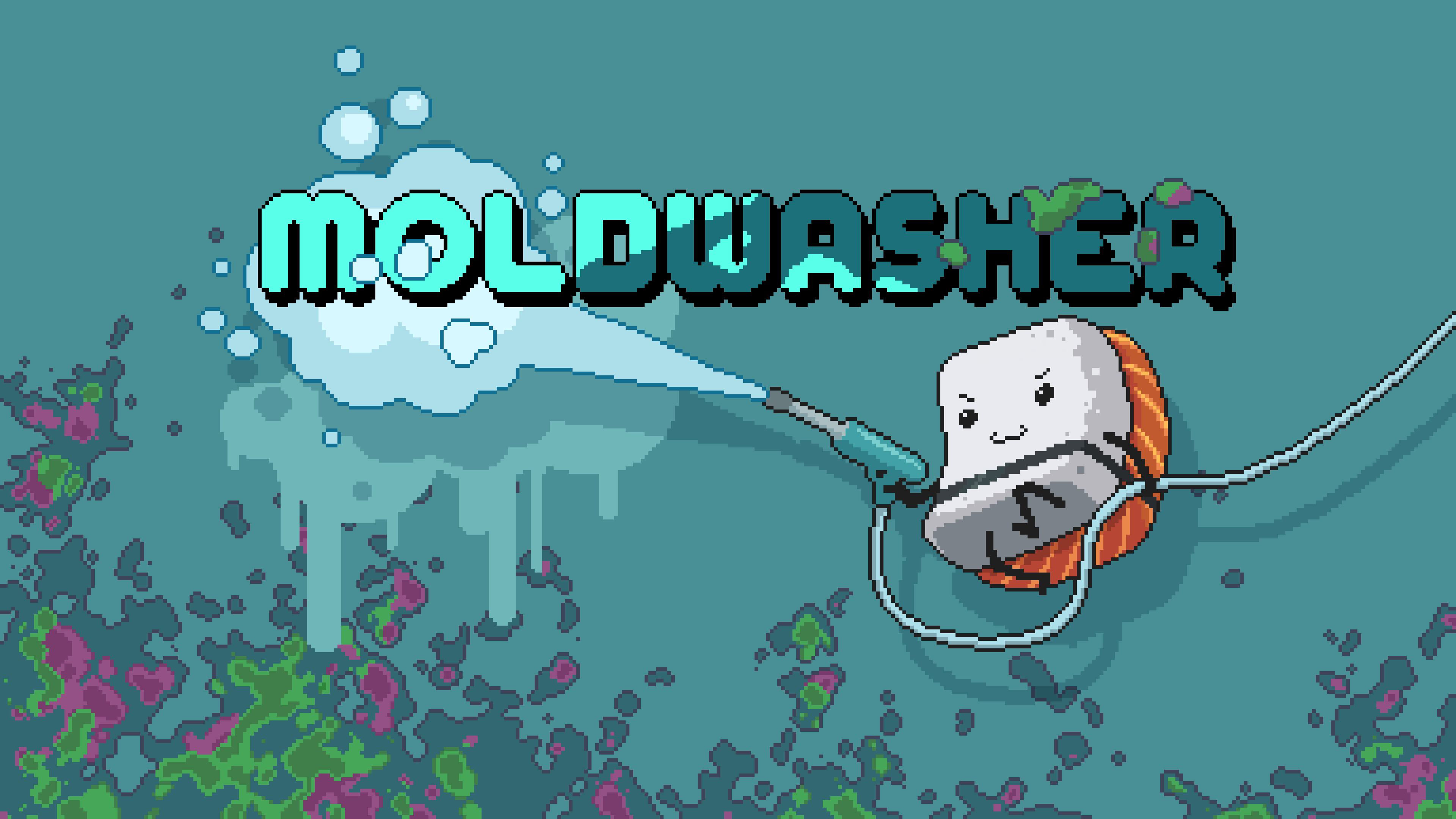
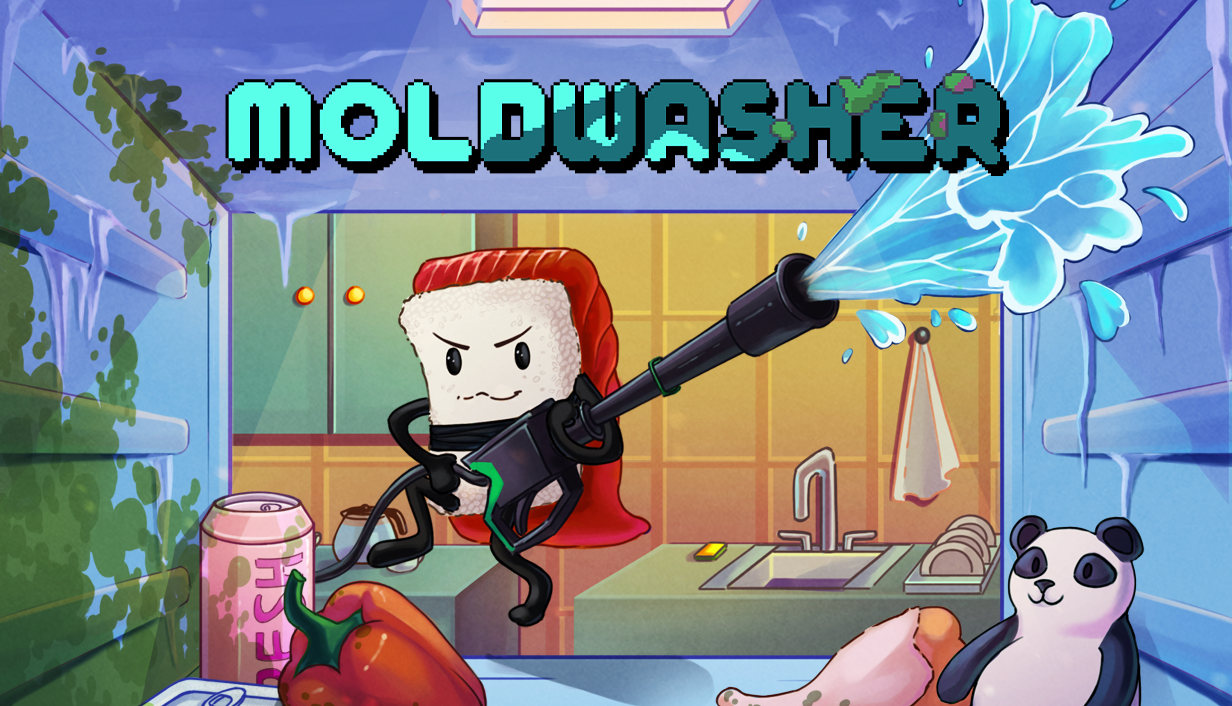 [/carousel]
[/carousel]What do you think? Do you like it?
/Moldwasher Team 🧽
─────────────────────────────────────────────
https://store.steampowered.com/app/3688130/Moldwasher ─────────────────────────────────────────────
https://steamcommunity.com/games/3688130/announcements/detail/539993196499829206 ─────────────────────────────────────────────










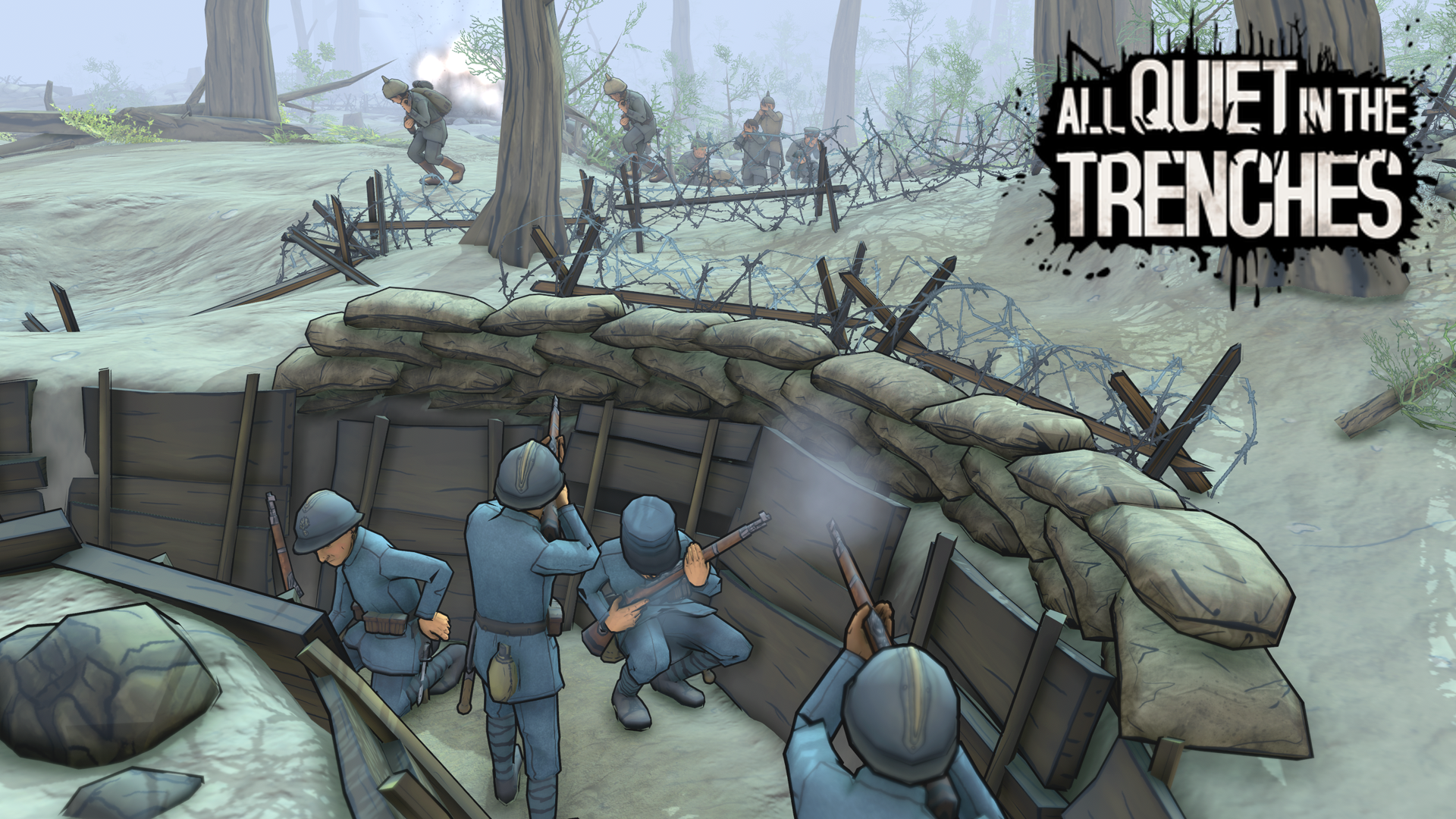
It's not long now until the release of the Soldier Update (0.10)!
In this Dev Diary, we want to show you how morale and a completely new NPC troop logic will affect the course of a battle.
In battles, the troop morale of enemy and allied troops is now displayed. It is calculated from the average morale of the active soldiers in the troop.
Troop morale directly affects the firepower of each individual soldier and also individual commands, such as the outcome of close combat or ‘fire back’ when suppressed. The morale of each individual troop also influences the course of the battle, i.e. which side will retreat first.
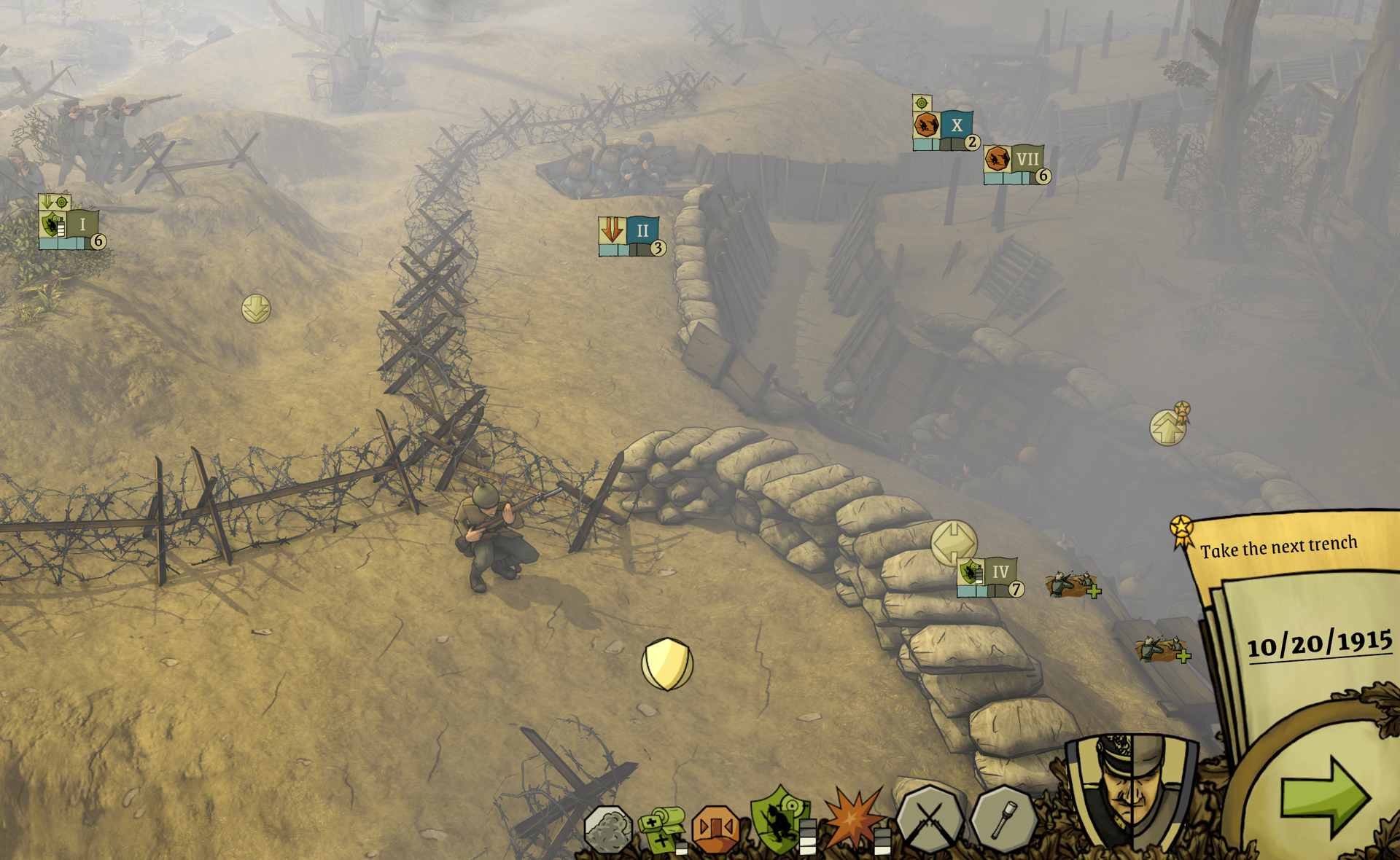
Troop morale is also divided into three levels: Resolute, Stable and Demoralised. These individual levels have a direct influence on how a troop behaves in battle.
With the introduction of troop morale, the stress of soldiers now plays a greater role. Stress increases more slowly and usually decreases more quickly, but it has an even greater effect on morale.
However, if a troop is suppressed, flanked or within melee range, none of the soldiers can reduce their stress. This means that you have to actively change position to boost morale or, for example, to prevent the soldiers from panicking.
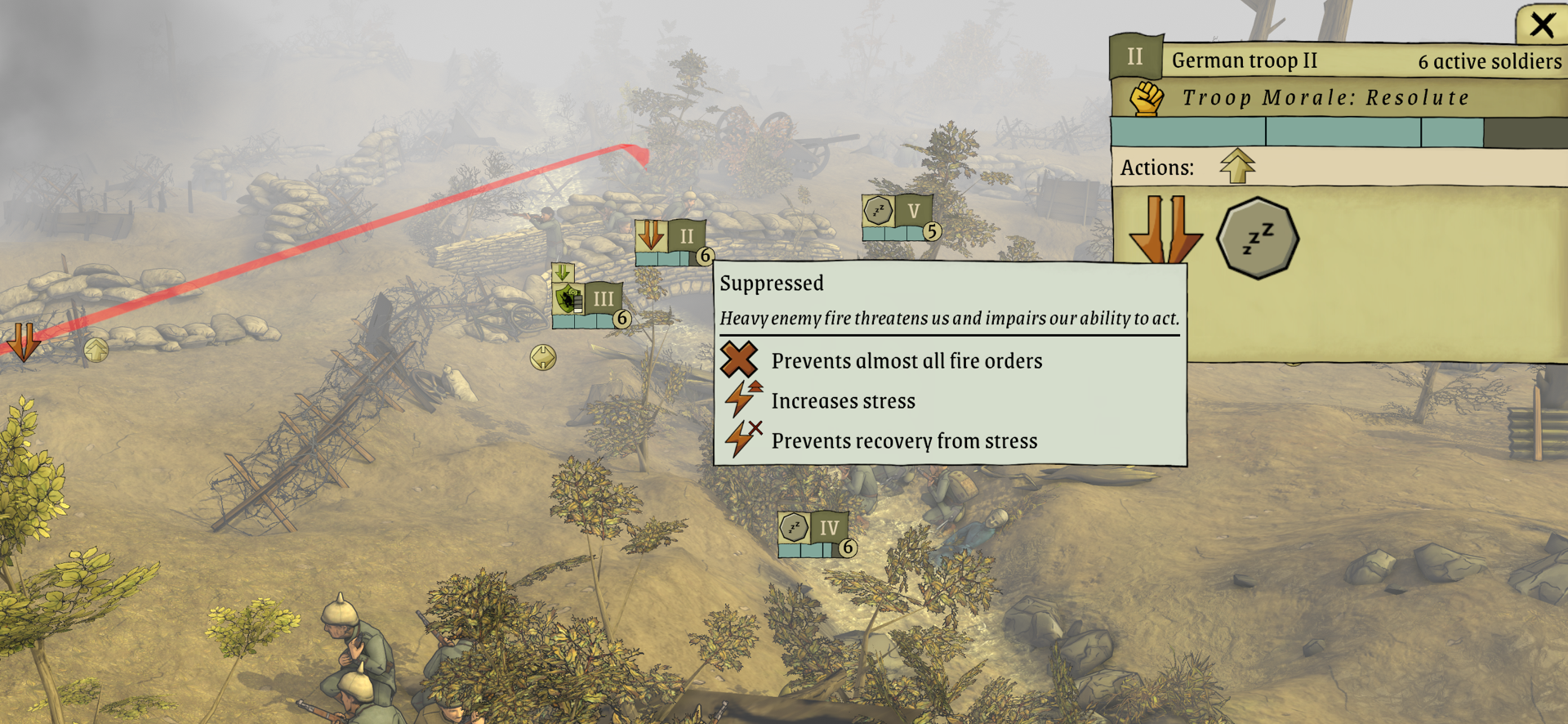
This should introduce a new tactical component: retreat and targeted weakening of enemy morale now play a greater role. Failures such as grenades that barely miss their target become more forgivable, as they still weaken enemy morale.
Furthermore, the individual levels of the Fervor attribute have been removed. However, fervor now greatly reduces stress per turn. Soldiers can also gain fervor more quickly if, for example, they hit an enemy soldier, rescue an allied soldier or even successfully cut through barbed wire (depending on their personality).
As part of these new features, we have completely redesigned the calculation of actions and commands for NPC troops.
Decisions are based on countless factors: cover, danger, injuries, equipment, proximity to the enemy, lines of sight, and much more. The old troop logic added up all these factors in order to ultimately perform the hopefully most reasonable™ action. This was usually very functional, but increasingly confusing and, in some situations, unrealistic and incomprehensible.
An example: A troop is in the best position for a close combat attack with movement to another position. However, it could also suppress at its current position, treat an injured soldier and search for equipment at the same time. The current position may even offer better cover. Although close combat was weighted very highly, this troop could decide to hold its position because all these values added up to a higher total.
An intermediate layer for the behaviour of troops on the battlefield has now been introduced. The higher layer (basic logic) consists of linking the main command (offensive, defensive and retreat) with the morale levels (resolute, stable and demoralised), resulting in a total of 9 different basic logics.
This basic logic only determines a behaviour pattern at first. A few examples:
Advance: ‘We want to move safely to the target position.’
Suppress: ‘To support allied troops, we want to effectively suppress enemy positions.’
Rally: ‘We want to regenerate our morale and gather scattered soldiers.’
Evacuate: ‘We want to rescue the wounded and take them to the hospital.’
Loot: ‘We want to search for ammunition, bandages or grenades.’
Destroy: ‘We want to eliminate enemy troops.’
and more ...
[c]Basic logic (e.g. Offensive & Determined) -> Behaviour pattern (e.g. Advance) ->
Troop action (e.g. Move to position x) & Soldier commands (e.g. Move & Covering fire)[/c]
To pick up on the example from earlier: The behaviour patterns of the troop are evaluated individually and they decide on Destroy in this situation. This behaviour leads to the troop engaging in close combat. In the next round, they may then decide on Evacuate in order to bring the wounded soldier to their current position or to return to their previous position.

The basic logic has different ratings: a resolute troop on the offensive will give higher weight to Destroy or Advance, while a demoralised troop will have the highest multiplier on Rally.
This new system is not only intended to force more realistic and comprehensible decisions, it is also much easier to debug.
Last but not least, NPC soldiers are now also simulated over the course of the war. Among other things, their war weariness or exhaustion at the beginning of a battle is influenced.
Troops have different values: some start out more determined and stronger, while others appear weakened and less motivated. As the war progresses, all troops are sent into battle with increasingly lower morale.
With these changes, we want to bring more transparency and depth to the battles. The new troop logic will not be perfect at release, but it will be much easier to understand and adapt, allowing us to expand it over the course of Early Access. It also opens up new tactical possibilities: enemy troops do not have to be physically defeated, but can be deliberately demoralised. The focus is not on eliminating enemies, but on forcing the opponent to surrender!


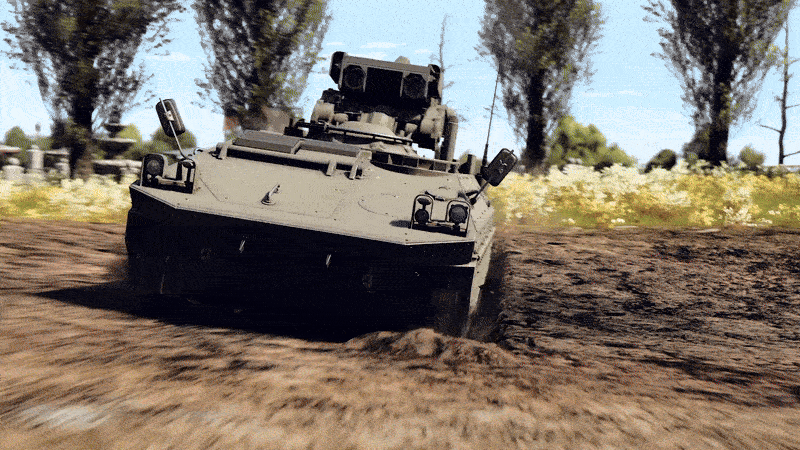
Today we’ll be taking a look at an experimental vehicle based on the C13 platform with TOW ATGMs and the ability to fire from behind cover!
C13 TUA: A Squadron Vehicle AT Missile Carrier for Italy at Rank VI
At a glance:
Folding launcher that fires the I-TOW ATGM
Cannot fire on the move
Light armor
Good mobility
Thermal imager
Development of the C13 began back in the 1970s as as private venture by Oto Melara. Designers looked to create a compact and multifunctional platform capable of carrying a variety of weapon modules, filling the gap between the aging American M113 and the promising Dardo combat vehicles. The first two prototypes, unveiled in 1983, were equipped with different turrets and were tested in various configurations over the following years. By 1987, a third prototype was built, and Oto Melara actively promoted the vehicle internationally as a replacement for the M113. Despite these efforts however, the project was canceled in 1999 due to a lack of orders.
The TUA (TOW Under Armor) anti-tank version carried a TOW ATGM launcher with eight missiles (two in the launcher and six stored in the hull) as its primary armament. The crew consisted of three members, a commander, driver and gunner. Light aluminum armor protected against small arms fire and shrapnel. The engine was an Isotta Fraschini Model ID 38 SS V6 diesel engine producing 360 HP and had a top speed of 70 km/h. The C13 TUA failed to secure a government contract and did not attract interest from potential foreign operators, leading to the cancellation of the project.
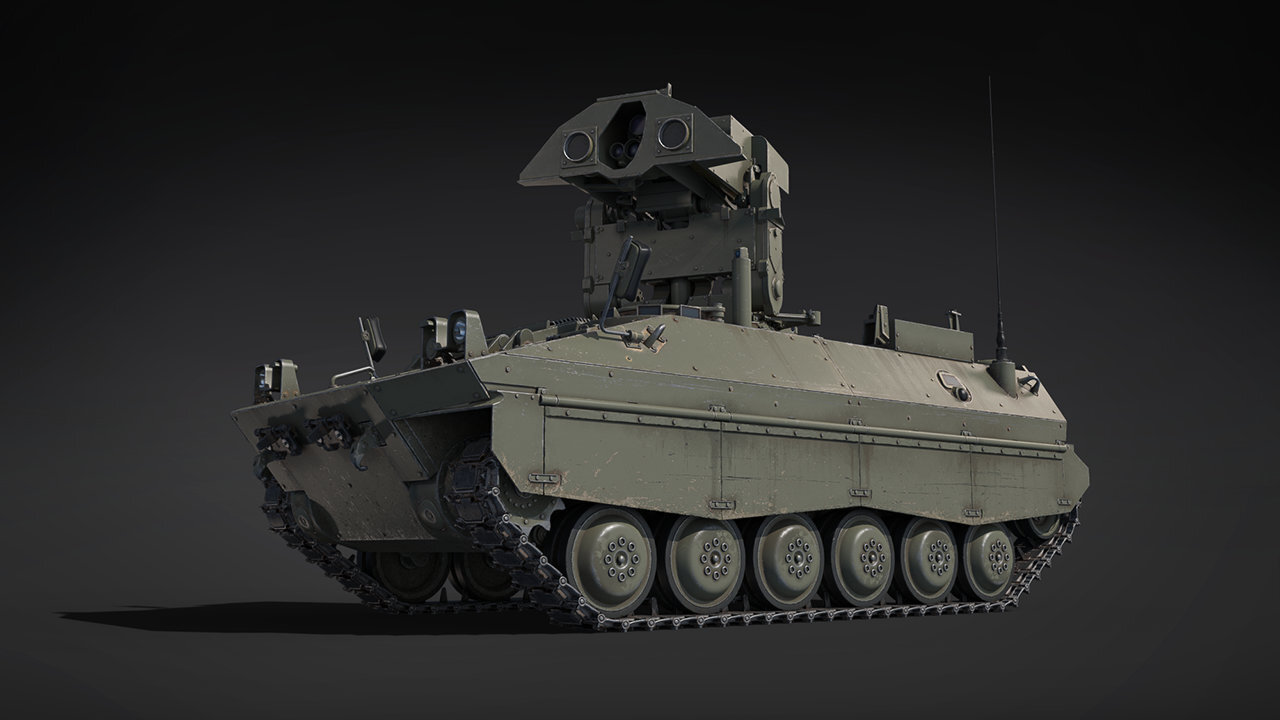
A new squadron vehicle coming to War Thunder in the next major update is the experimental Italian C13 TUA anti-tank missile carrier, equipped with a deployable TOW anti-tank missile launcher capable of firing with its hull completely hidden behind low obstacles. Let’s dive into the details!
The C13 TUA may look familiar to you, and that’s because this vehicle, produced by OTO Melara, uses the same launcher found on the American M901. The general layout is also similar, which means the style of play found on the M901 will carry right over to the C13 TUA.
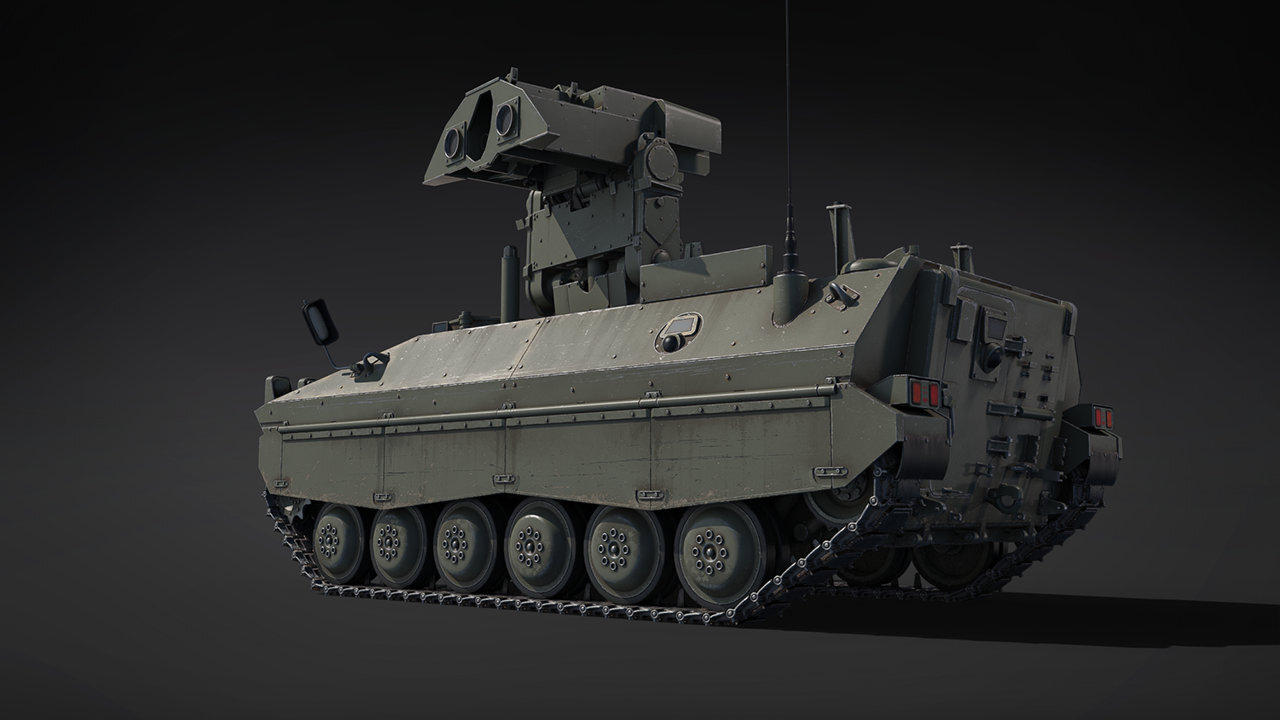

The launcher that holds two I-TOW missiles side-by-side folds out and elevates itself above the vehicle’s chassis, and the optics with the thermal sights are located between the missile tubes. When you setup and pick a spot that has some cover, the entire hull of this vehicle will be concealed, allowing you to fire with just the launcher exposed to the enemy. Bear in mind that if the launcher is hit by enemy shells, it becomes disabled and can resume normally after being repaired.


If you’ve played the M901, you’ll know that the setup of the C13 TUA will have some limitations. Namely, it can only fire when fully static, and it takes a certain amount of time for the launcher to raise into its firing position. The C13 TUA is definitely not great for active combat due to this, plus its light armor which is only bulletproof, making you a seriously easy target for enemy tanks and aircraft when on the move. The weak armor also exposes the C13 TUA to the blast of high-explosive shells, which can easily penetrate the roof of the hull, even if they hit the launcher. Mobility is good however, the maximum speed of 70 km/h allows it to quickly reach strong positions at the start of the battle, and it can quickly reposition in both urban and rough terrain.
So, that’s the rank VI C13 TUA for you! It’s Italy’s first squadron vehicle, and can be obtained with squadron activity points or for Golden Eagles. See you in future dev blogs!

Please note that this vehicle’s characteristics may be changed before it is added to the game.

Hello Tamers!
In this devlog, we're taking you behind the scenes to showcase our progress on the turn-based battle system! We'll be covering the UI, animations, system mechanics, and more. Let's dive in! 🙂
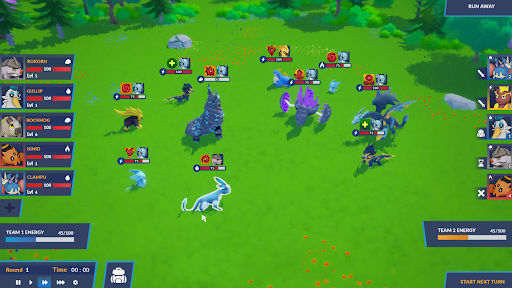
When working on the UI, we followed a simple principle: "minimum distractions, maximum information." We want you to be able to make strategic decisions in a split second.
In the new UI, everything has its place:
On the sides, you'll find the team rosters with their key stats.
At the bottom, we've placed the shared Team Energy bar - a resource you'll have to manage carefully each turn.
Above the characters, status icons hover, so you can instantly see who is buffed and who is weakened.
Our goal is an interface that is intuitive from the very first battle, yet provides all the data needed to plan advanced tactics.
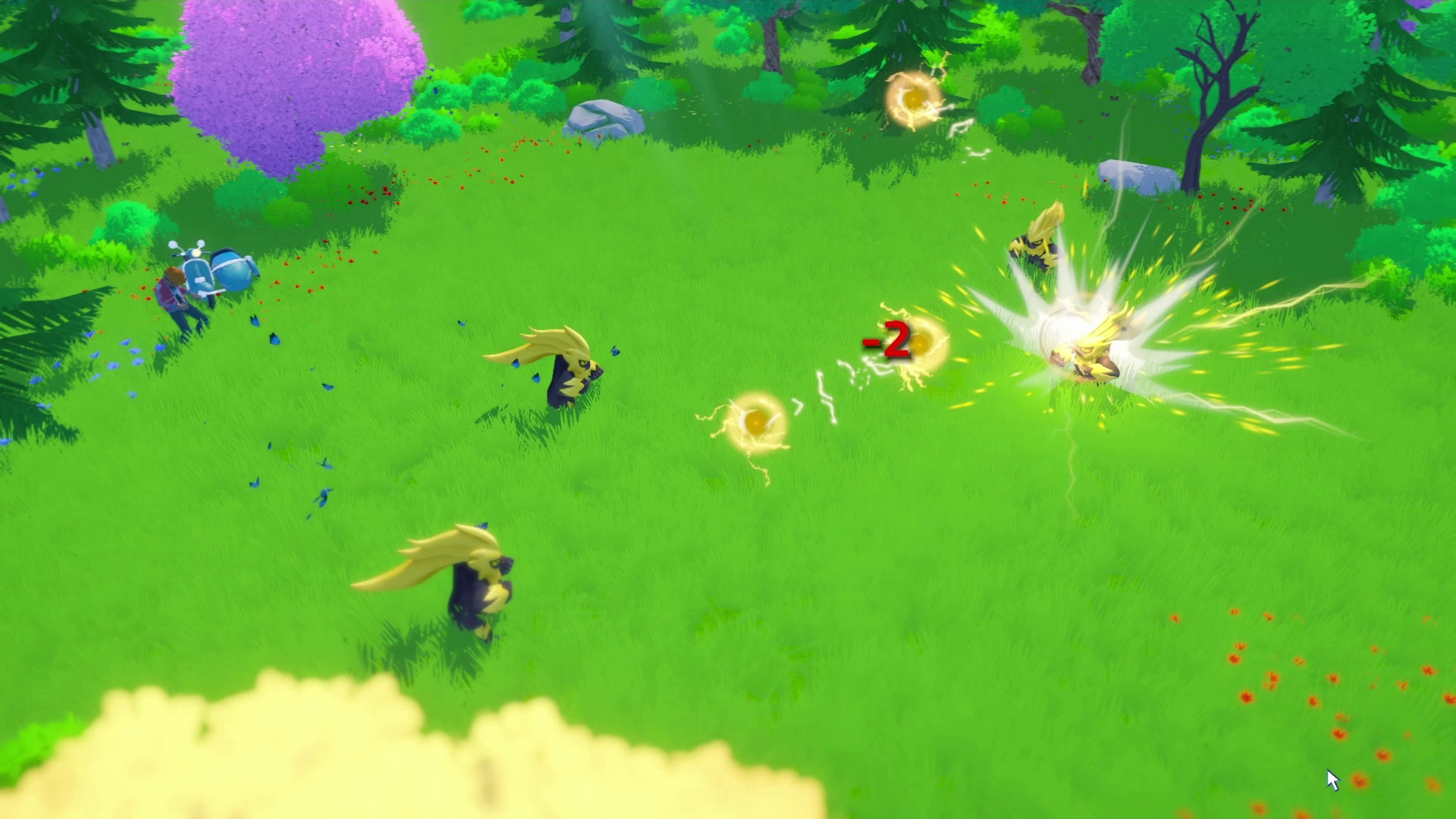
What's a battle without some proper explosions and spectacular skills? Our priority right now is adding more "juiciness" to the gameplay. Every attack, every hit, and every dodge needs to feel impactful.
The screenshot shows an effect for one of our basic attacks. We're working to make even the simplest actions feel spectacular and fun. You can be sure that the more powerful abilities will be even more impressive!
We’re still hard at work polishing every corner of Tamer Town to make it the best.
Stay tuned for the next update - we can’t wait to show you what’s coming next!
The Tamer Town Development Team
https://store.steampowered.com/app/3939760/Path_to_Tamer_Town/

The candle gutters in its holder, throwing long shadows over the cluttered desk. The Quartermaster rubs his eyes, the ink on his fingertips long since dried into faint stains. The day’s duties were meant to be over hours ago - requisitions filed, rations tallied, reports sent. But the figures don’t align anymore. The systems he built in calmer weeks have begun to crumble under the strain. What once sufficed now fails under the weight of chaos.
He exhales, steady but tired. The front has grown unpredictable - supply lines twisting through mud and rumor alike. Convoys vanish into fog, reports contradict one another, and the old forms no longer capture the truth of the situation. To keep order, he must unmake it first.
So, he begins again. Pages are torn from ledgers. Old tables are replaced. Formulas rewritten. The structure of his own record - his entire way of keeping the war alive on paper - must be reforged. It is not enough to count anymore; he must adapt.
Each new line is a small rebellion against exhaustion, against the creeping sense that this is all futile. But survival depends on clarity, and clarity demands rebuilding. The work becomes slower as the night deepens - calculation, revision, redrawing. He sketches new columns, invents new rules, finds new ways to make sense of senselessness.
Somewhere beyond the walls, men sleep in their trenches. He envies them. But he knows that if his system fails, dawn will find them without food, without fuel, without hope. And so, he keeps writing.
By the time the candle burns low, the ledger is only half-rewritten - fragments of a new order scattered between the old. His eyes blur over the lines, his hand too heavy to steady the pen. The work is far from done, but the night has taken its toll. Tomorrow, the routine duties will return - the requisitions, the deliveries, the endless signatures that keep the front moving - and this overhaul will have to wait until the silence of another night.
Still, he knows what failure would mean. If the new system is not finished, if the records remain flawed, the sector will unravel - not from shellfire, but from disarray. The men fight with rifles and shovels; he fights with ink and paper. Their exhaustion is his own.
He lets the pen rest at last, not in surrender but in deferral. The battle will continue tomorrow - the unseen one, fought in margins and columns, where survival depends on order wrestled from chaos.
---
After the last milestone, the codebase reached a stage where I could properly test and observe how the majority of relevant systems interacted - resource flow, unit logic, events, and modifiers. That first preliminary version taught me a lot about what the engine really needs to handle under the hood.
So, I decided to go back to the foundation and rebuild parts of it for efficiency, flexibility, and long-term scalability.
I’m currently refactoring the core systems to make them cleaner and much easier to upgrade later on. The goal is to ensure that every part of the game - from unit stats to global events - communicates in a structured, efficient way.
The new modifier system is the biggest change. It’s now far more modular and data-driven:
Modifiers can
affect stats directly,
trigger custom methods, or
modify tracked variables dynamically (like counting scarcity or morale events).
They’re also fully condition-based - meaning you can define when and how they activate with simple logic, e.g. “if ammo < 10% of use → apply penalty to combat effectiveness”.
That flexibility will be crucial for building complex behaviors later without rewriting large chunks of code.
Rebuilt the modifier architecture (types, scopes, and conditions)
Centralized modifier processing to avoid redundant loops and overlaps
Added validation to prevent missing keys or undefined effects
Introduced method-trigger and variable-update support
Improved dictionary structures for stats, thresholds, and entities
Refactored base classes for units and sectors for cleaner inheritance
Optimized signal connections for daily updates
Enhanced logging and debug output for testing
Simplified initialization and scene setup
Once this version of the core systems is complete, I’ll move toward central logistics and relation system between the player and the commanders.
That means, with this iteration of the core codebase, I think we'll get to the playtesting stage.
It won’t have proper visuals yet - mostly grey boxes, text, and dropdown menus - but it’ll be enough to test all loops, balancing, and interactions.
It’s the first time the simulation will really start to “breathe.”
Legend:
White -> Not started
Yellow -> System has been started upon.
Orange -> System is applied. (Which means it's already functioning and interconnected with the other systems.)
Blue -> System is finished. It works as it should and was tested.
Green -> Polished and finished. All the balancing and little extra things are done. Ready to be shipped and to be left alone.
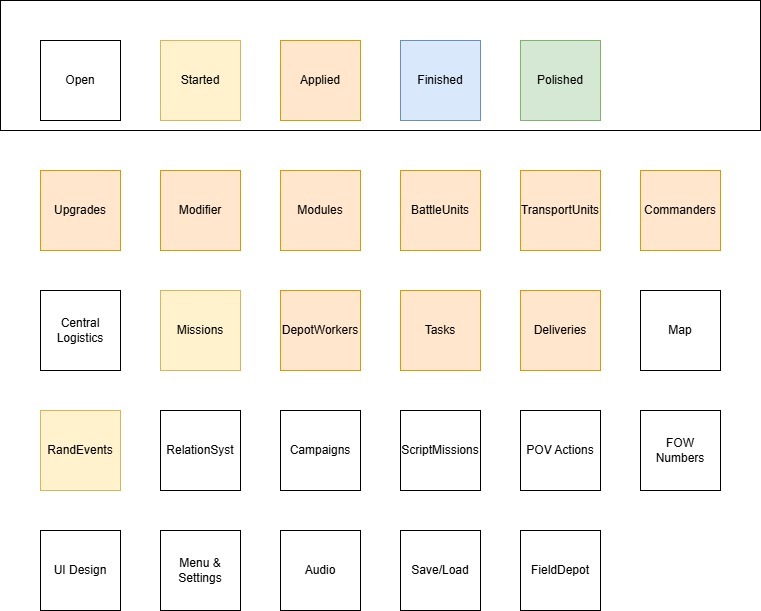

Hello everyone
A huge thank you for all the additional feedback following release of the demo. The quality and volume of your feedback since Patch 0.08 have been incredible. Please continue to post on the Managate Discord Server if you have any feedback or have found any bugs. Patch 0.09 is a massive step forward, bringing a huge number of quality-of-life improvements and new content. Our main goal was to improve the moment to moment gameplay, while also adding more visual clarity, fixing a ton of bugs, and adding a brand new challenge for you to play.
A powerful new legendary minion has been added to the world that you can fight and capture.
The entire Affix system has been refined and improved for more build diversity and impact. You can now create some new ridicously overpowered combinations.
New visual cues during combat and base activities to make the game state much clearer.
The new player experience has been further refined to be even more streamlined and helpful.
Many bugs fixed.
Thank you again for being such an essential part of our development. Please keep the feedback coming. You can always reach us on Discord.